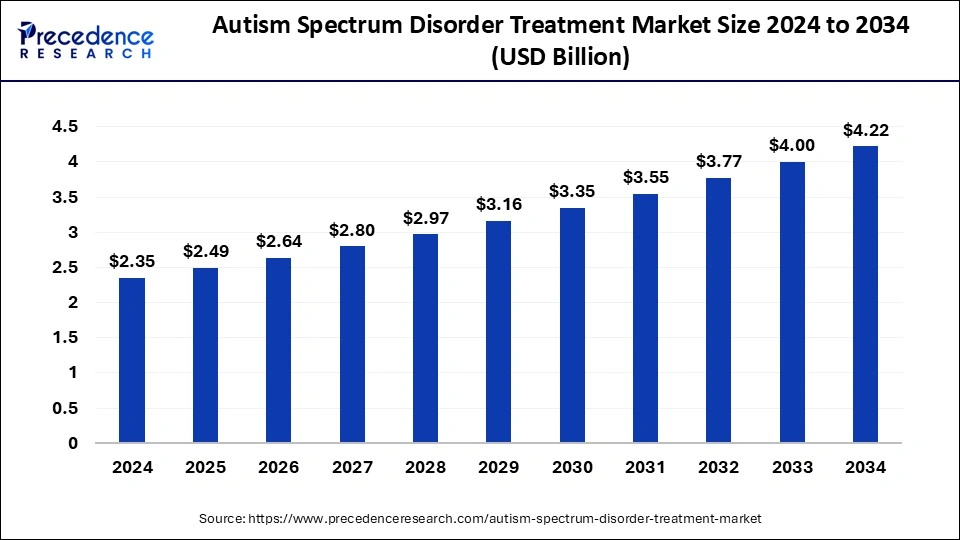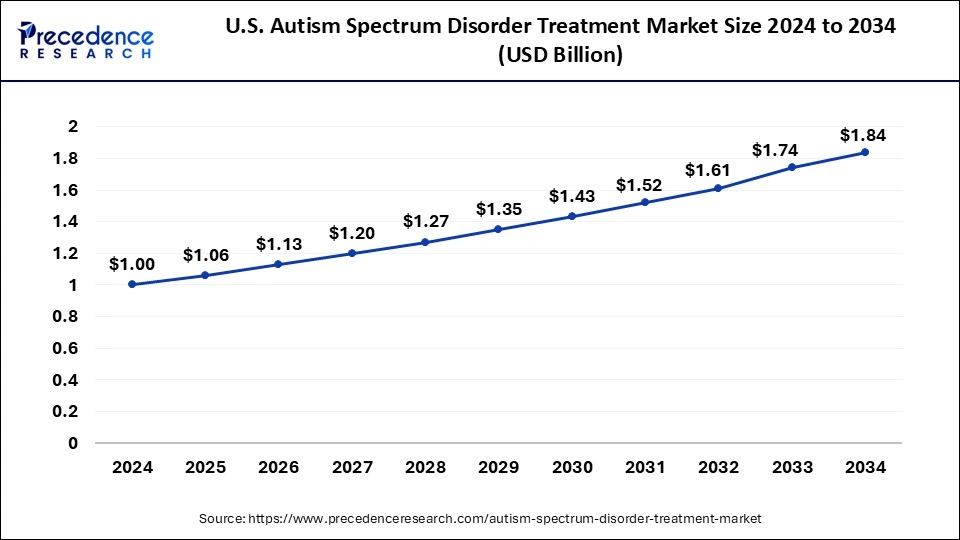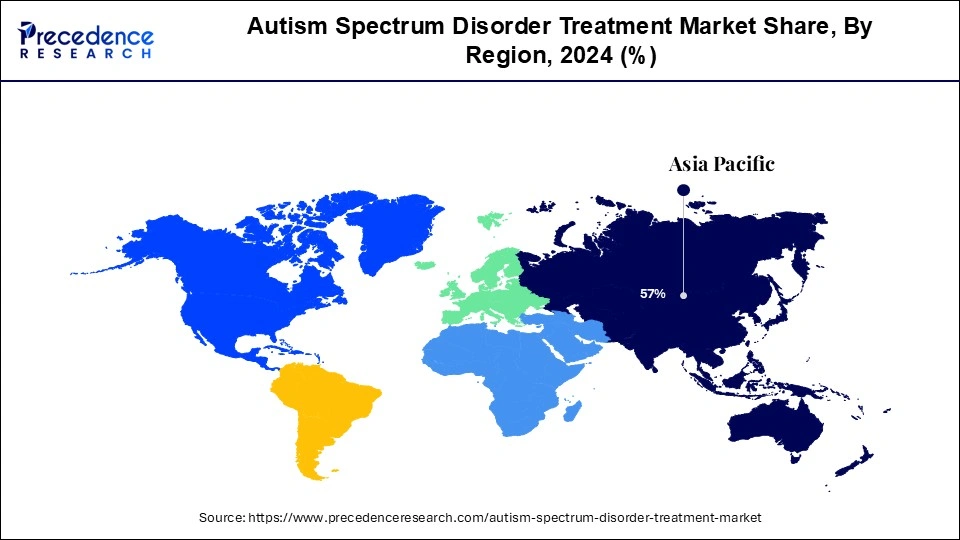December 2024
The global autism spectrum disorder treatment market size is calculated at USD 2.49 billion in 2025 and is forecasted to reach around USD 4.22 billion by 2034, accelerating at a CAGR of 6.03% from 2025 to 2034. The North America market size surpassed USD 1.34 billion in 2024 and is expanding at a CAGR of 6.05% during the forecast period. The market sizing and forecasts are revenue-based (USD Million/Billion), with 2024 as the base year.
The global autism spectrum disorder treatment market size accounted for USD 2.35 billion in 2024 and is predicted to increase from USD 2.49 billion in 2025 to approximately USD 4.22 billion by 2034, expanding at a CAGR of 6.03% from 2025 to 2034. The autism spectrum disorder treatment market is driven by the rising diagnosis rates for autism.

The U.S. autism spectrum disorder treatment market size was exhibited at USD 1.00 billion in 2024 and is projected to be worth around USD 1.84 billion by 2034, growing at a CAGR of 6.29% from 2025 to 2034.

North America dominated in the autism spectrum disorder treatment market in 2024. Modern healthcare facilities with the latest technology for ASD diagnosis and treatment are abundant in North America, especially in the United States and Canada. This infrastructure supports comprehensive and early intervention programs, which are essential for controlling ASD. North American governments provide large sums of money for research on ASD. For example, the United States National Institute of Health (NIH) generously funds research into autism, advancing our knowledge of and ability to treat the condition.

Asia-Pacific shows a notable growth in the autism spectrum disorder treatment market during the forecast period. Public and medical professionals now better understand and recognize ASD due to increased awareness initiatives by governments and nonprofits. Early diagnosis rates have grown due to improvements in diagnostic equipment technology and greater training for healthcare professionals. Better treatment outcomes depend on early intervention, which fuels market expansion.
The quality and accessibility of therapies for ASD are improving due to the swift expansion of healthcare infrastructure in nations such as China, India, and Japan. Access to ASD therapies has increased with telemedicine and digital health platforms, especially in rural and underserved locations.
The autism spectrum disorder treatment market is the market for treatments and interventions aimed at reducing symptoms, improving quality of life, and encouraging functional independence in people with autism spectrum disorders. This covers medication therapy, educational strategies, supportive services, assistive technology, and behavioral therapies.
The number of people diagnosed with ASD has increased globally due to increased awareness and better diagnostic methods, which has increased the demand for treatment options. The treatment market is expanding due to increased funding for ASD research and development from governments, insurance companies, and private investors.
| Report Coverage | Details |
| Market Size by 2034 | USD 4.22 Billion |
| Market Size in 2025 | USD 2.49 Billion |
| Market Size in 2024 | USD 2.35 Billion |
| Market Growth Rate from 2025 to 2034 | CAGR of 6.03% |
| Largest Market | North America |
| Base Year | 2024 |
| Forecast Period | 2025 to 2034 |
| Segments Covered | Treatment Type, Application, Distribution Channel, and Regions |
| Regions Covered | North America, Europe, Asia-Pacific, Latin America, and Middle East & Africa |
Growing number of diagnosed cases of ASD
The increase in diagnosed cases has sparked research and development efforts in the treatment of ASD. As a result, novel pharmaceutical interventions, targeted therapies, and creative behavioral methods have been identified and developed as new therapeutic choices. The availability of more effective treatments facilitates the rise of the market. Technological developments have greatly aided improvements in ASD treatment choices. Technologies such as virtual reality therapy, wearable behavior monitoring devices, and telehealth services have been developed to meet the unique needs of people with ASD. These developments expand the market and enhance the effectiveness of treatments. This drives the growth of the autism spectrum disorder treatment market.
Improved insurance coverage and reimbursement policies for ASD treatments
For children with ASD to improve in terms of behavior, social skills, and communication, early intervention is essential. Families will seek early diagnostic and intervention services when insurance coverage improves. For those with ASD, this early assistance can significantly enhance their long-term prognosis. Greater investment in research and development within the ASD treatment industry may result from increased demand for improved insurance coverage. This may lead to improvements in treatments, identification methods, and technological solutions that enhance the lives of people with ASD.
Limited insurance coverage
Comprehensive and frequently extended therapy and intervention programs, such as behavioral therapy, speech therapy, occupational therapy, and occasionally medication, are necessary for ASD. These treatments can get pricey, particularly if needed for a long time. Inadequate coverage may make it difficult to obtain essential services. Individuals with ASD may receive treatment regimens that are insufficient or ineffective because their families cannot pay for the entire spectrum of therapies advised.
Families with inadequate coverage could choose less expensive solutions or fewer sessions than what medical professionals advise. This may lower the standard and efficacy of care, which could have an impact on the long-term results for people with ASD. This limits the growth of the autism spectrum disorder treatment market.
Development of new and innovative therapies
The number of ASD diagnoses is rising in tandem with a global increase in awareness of the disorder. This pattern emphasizes how urgently effective treatments are needed to enhance the quality of life for those who are autistic. There is no known cure for ASD, and most available therapies concentrate on controlling its symptoms, including trouble with social relationships, repetitive behaviors, and communication. Creating novel treatments that target these fundamental symptoms may close significant gaps in available therapeutic choices. This opens an opportunity for the growth of the autism spectrum disorder treatment market.
The stimulants segment dominated the autism spectrum disorder treatment market in 2024. It has been discovered that stimulants, notably methylphenidate (also marketed as Ritalin), help treat some of the symptoms linked to ASD, particularly the symptoms of attention deficit hyperactivity disorder (ADHD), which frequently co-occurs with autism. More adults and children are receiving accurate diagnoses of ASD and associated comorbid illnesses thanks to increased awareness and improvements in diagnostic methods. Early diagnosis frequently results in early intervention, one of which may be the use of stimulant drugs.
Pharmaceutical corporations have made significant investments in stimulant drug development and marketing to ensure they are widely available and have a strong market presence.
The antipsychotic drugs segment shows a notable growth in the autism spectrum disorder treatment market during the forecast period. Antipsychotic medications have shown promise in the treatment of ASD symptoms like aggression, impatience, and self-harming behaviors. By lowering severe behavioral difficulties, these drugs can dramatically enhance the quality of life for patients and their families. Several antipsychotic medications have been licensed by regulatory agencies, including the U.S. Food and Drug Administration (FDA), to treat irritability linked to autism spectrum disorders. These approvals significantly boost the market.
The autistic disorder segment dominated the autism spectrum disorder treatment market in 2024. When it comes to ASDs, autistic disorder is more common than Asperger's syndrome and pervasive developmental disorder not otherwise defined (PDD-NOS). Autistic disorder is the more severe end of the spectrum. The market for therapies aimed at treating autism disorders inevitably grows due to this increased prevalence. People who have autism disorder usually have more severe symptoms, such as significant difficulties with social interaction, communication, and repetitive habits. Treatments for severe symptoms must be more extensive and frequently ongoing due to their intensity.
The retail pharmacy segment dominated the autism spectrum disorder treatment market in 2024. Due to their vast network, retail pharmacies make sure that many people can quickly obtain drugs for ASD. Because of its widespread availability, patients and caregivers can soon get the prescription drugs they need without driving far. Retail pharmacies frequently provide management services and automated refill reminders to help patients stick to a regular medication schedule, which is essential for the success of ASD therapy.
Robust internet systems are available for many retail pharmacies, enabling virtual consultations, medicine delivery, and prescription refills. These services, which provide convenience and lessen the stress of frequent pharmacy trips, benefit families managing autism spectrum disorder.
The hospital pharmacy segment shows a significant growth in the autism spectrum disorder treatment market during the forecast period. There is an increased need for specific treatment alternatives due to the growing prevalence of ASD worldwide. Hospital pharmacies are quickly emerging as essential locations for monitoring treatment regimens and distributing drugs to patients with ASD. A multimodal strategy for treating ASD patients is typically necessary, including the use of drugs to control symptoms, including hyperactivity, aggression, and irritability. Hospital pharmacies collaborate closely with medical professionals to provide all-encompassing care, monitor medication interactions, and modify therapies as necessary to achieve the best results.
By Treatment Type
By Application
By Distribution Channel
By Geography
For inquiries regarding discounts, bulk purchases, or customization requests, please contact us at sales@precedenceresearch.com
No cookie-cutter, only authentic analysis – take the 1st step to become a Precedence Research client
December 2024
January 2025
November 2024
June 2024